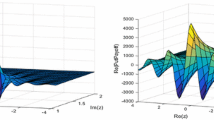Abstract
In this paper, using a geometric method introduced in (Henry-Labordère Large Deviations and Asymptotic Methods in Finance (2015) [12]) and initiated by (Avellaneda et al. Risk Mag. (2002) [4]), we derive an asymptotic swaption implied volatility at the first-order for a general stochastic volatility Libor Market Model. This formula is useful to quickly calibrate a model to a full swaption matrix. We apply this formula to a specific model where the forward rates are assumed to follow a multi-dimensional CEV process correlated to a SABR process. For a caplet, this model degenerates to the classical SABR model and our asymptotic swaption implied volatility reduces naturally to the Hagan-al formula (Hagan et al. Willmott Mag. 88–108 (2002) [11]). The geometry underlying this model is the hyperbolic manifold \({\mathbb H}^{n+1}\) with n the number of Libor forward rates.
Access this chapter
Tax calculation will be finalised at checkout
Purchases are for personal use only
Similar content being viewed by others
Notes
- 1.
An at-the-money swaption (ATM) has a strike K equal to the spot rate \(s_{\alpha \beta }(0)\) and an out-of-the money (OTM) (resp. in-the-money (ITM)) swaption has \(K<s_{\alpha \beta }(0)\) (resp. \(K>s_{\alpha \beta }(0)\)).
- 2.
We have used a predictor-corrector scheme with a Brownian bridge.
References
Andersen, L., Andreasen, J.: Volatility skews and extensions of the Libor market model. Appl. Math. Financ. 7(1), 1–32 (2000)
Andersen, L., Andreasen, J.: Volatile volatilities. Risk 15(12), 163–168 (2002)
Andersen, L., Brotherton-Ratcliffe, R.: Extended Libor market models with stochastic volatility. J. Comput. Financ. 9(1), 1–40 (2005)
Avellaneda, M., Boyer-Olson, D., Busca, J., Fritz, P.: Reconstructing the smile. Risk Mag. (2002)
Berestycki, H., Busca, J., Florent, I.: Asymptotics and calibration of local volatility models. Quant. Financ. 2, 31–44 (1998)
Brace, A., Gatarek, D., Musiela, M.: The market model of interest rate dynamics. Math. Financ. 7, 127–154 (1996)
Brigo, D., Mercurio, F.: Interest Rate Models, Theory and Practice. Springer Finance. Springer, Berlin (2015)
Erdély, A.: Asymptotic Expansions. Dover, New York (1956)
Hull, J., White, A.: Forward rate volatilities swap rate volatilities, and the implementation of the Libor market model. J. Fixed Income 3, 46–62 (2000)
Hull, J., White, A.: The pricing of options on assets with stochastic volatilities. J. Financ. 42, 281–300 (1987)
Hagan, P., Kumar, D., Lesniewski, A., Woodward, D.: Managing smile risk. Willmott Mag. 84–108 (2002)
Henry-Labordère, P.: A General Asymptotic Implied Volatility for Stochastic Volatility Models. http://arxiv.org/abs/condmat/0504317
Henry-Labordère, P.: Solvable local and stochastic volatility models: supersymmetric methods in option pricing. Quant. Financ. 7(5), 525–535 (2007)
Jamshidian, F.: Libor and swap market models and measures. Financ. Stoch. 1(4), 293–330 (1997)
Kawai, A.: A new approximate swaption formula in the Libor model market: an asymptotic approach. Appl. Math. Financ. 10(1), 49–74 (2003)
Piterbarg, V.: A stochastic volatility forward Libor model with a term structure of volatility smiles, SSRN
Rebonato, A.: On the pricing implications of the joint lognormal assumption for the swaption and cap markets. J. Comput. Financ. 3(3), 5–26 (1999)
Terras, A.: Harmonic Analysis on Symmetric Spaces and Applications, vol. I, II. Springer, New York (1985, 1988)
Author information
Authors and Affiliations
Corresponding author
Editor information
Editors and Affiliations
Appendices
Appendix A: Heat Kernel Expansion
An short-time expansion of the conditional probability for a multi-dimensional Itô diffusion process can be achieved using the heat kernel expansion. In that purpose, the Kolmogorov equation is rewritten as the heat kernel equation on a (n)-dimensional Riemannian manifold \({\mathcal M}^{n}\) endowed with an Abelian connection as explained in [12, 13]. Let’s assume that our multi-dimensional stochastic equations (in \({\mathbb Q}^{\alpha \beta }\)) are written as
with \(dW_\mu dW_\nu =\rho _{\mu \nu }(t)dt\). Then, the metric \(g_{\mu \nu }\) depends only on the diffusion terms \(\sigma _\mu \) and the connection \({\mathcal A}_\mu \) on the drift terms \(b_\mu \) as well
with \(g(t,x) \equiv \det [g_{\mu \nu }(t,x)]\). In terms of these functions, the asymptotic solution to the Kolmogorov equation in the short-time limit is given by
-
Here, \(\sigma (x,x^0)\) is the Synge function defined as
$$\begin{aligned}\sigma (x,x^0)={d^2(x,x^0) \over 2} \end{aligned}$$The distance \(d(x,x^0)\) is defined as the minimizer of
$$\begin{aligned}d(x,x^0)^2=\min _{C} \int _0^T g_{\mu \nu }(t=0,x) {dx_\mu (t) \over dt} {dx_\nu (t) \over dt} dt \end{aligned}$$and t parameterizes the curve \(\mathcal{C}(x,x^0)\) joining \(x(t=0)\equiv x^0\) and \(x(T)\equiv x\).
-
\(\Delta (x,x^0)\) is the so-called Van Vleck-Morette determinant
$$\begin{aligned} \Delta (x,x^0)=g(0,x)^{-{1 \over 2}}\det (-{\partial ^2 \sigma (x,x^0) \over \partial x \partial x^0})g(0,x^0)^{-{1 \over 2}} \end{aligned}$$(5.3)with \(g(x)=\det [g_{\mu \nu }(0,x)]\)
-
\(\mathcal{P}(x,x^0)\) is the parallel transport of the Abelian connection along the geodesic \(\mathcal{C}(x,x^0)\) from the point x to \(x^0\).
$$\begin{aligned} \mathcal{P}(x,x^0)=e^{-\int _{\mathcal{C}(x^0,x)} \mathcal{A}_\mu (t=0,x) dx^\mu } \end{aligned}$$(5.4) -
The \(a_i(x,x^0)\) are smooth functions on \({\mathcal M}^{n}\) and depend on geometric invariants such as the scalar curvature R. More details can be found in [12].
Appendix B: Saddle-Point Method
The integration over \({\mathbb B}\) is obtained by using a saddle-point method which consists in approximating at the first order the integral \(\int f(x) e^{ \epsilon \phi (x)} dx \) in the limit \(\epsilon \) large by [8]
with \(A^{\alpha \beta }=[\partial _{\alpha \beta } \phi ]^{-1}\), \(dx \equiv \prod _{i=1}^n dx_i\) and \(x^*\) the saddle-point (which minimizes \(\phi (x)\)). Here we have used Einstein summation convention. This expression can be obtained by developing \(\phi (x)\) and f(x) in series around \(x^*\). The quadratic part in \(\phi (x)\) leads to a Gaussian integration over x which can be performed.
Rights and permissions
Copyright information
© 2015 Springer International Publishing Switzerland
About this paper
Cite this paper
Henry-Labordère, P. (2015). Unifying the BGM and SABR Models: A Short Ride in Hyperbolic Geometry. In: Friz, P., Gatheral, J., Gulisashvili, A., Jacquier, A., Teichmann, J. (eds) Large Deviations and Asymptotic Methods in Finance. Springer Proceedings in Mathematics & Statistics, vol 110. Springer, Cham. https://doi.org/10.1007/978-3-319-11605-1_3
Download citation
DOI: https://doi.org/10.1007/978-3-319-11605-1_3
Published:
Publisher Name: Springer, Cham
Print ISBN: 978-3-319-11604-4
Online ISBN: 978-3-319-11605-1
eBook Packages: Mathematics and StatisticsMathematics and Statistics (R0)




